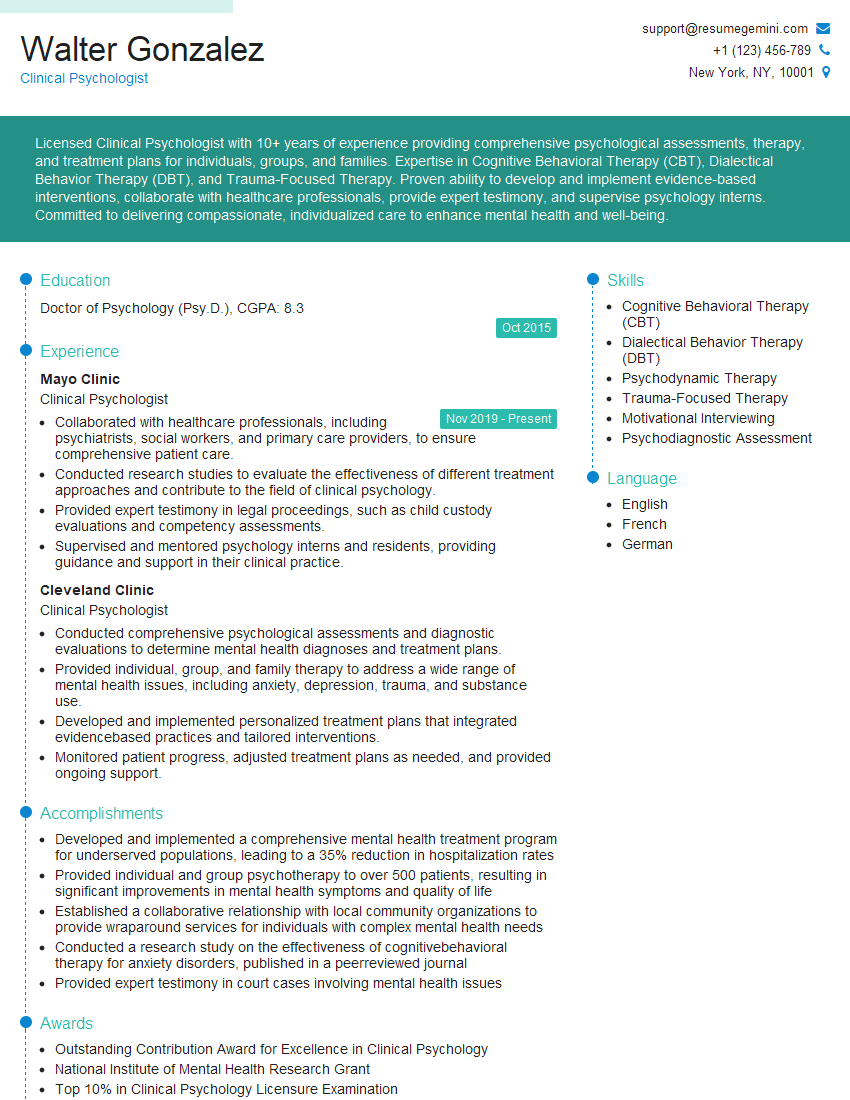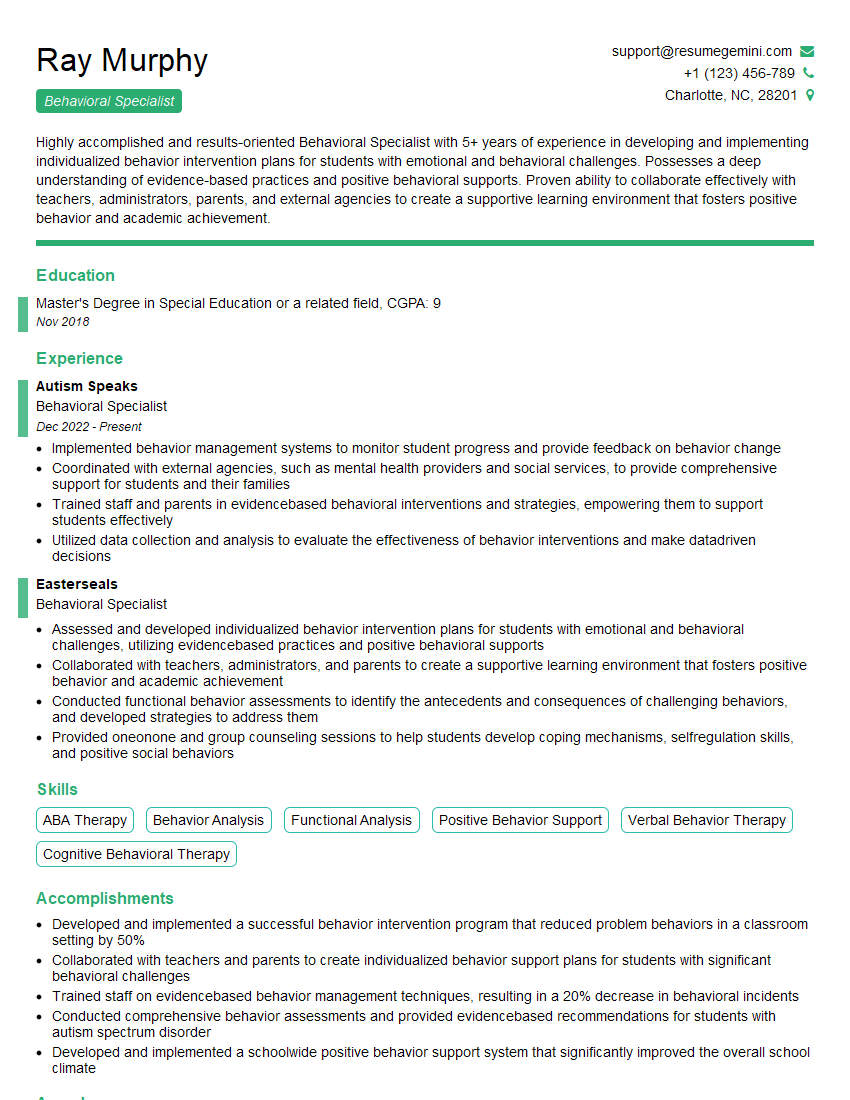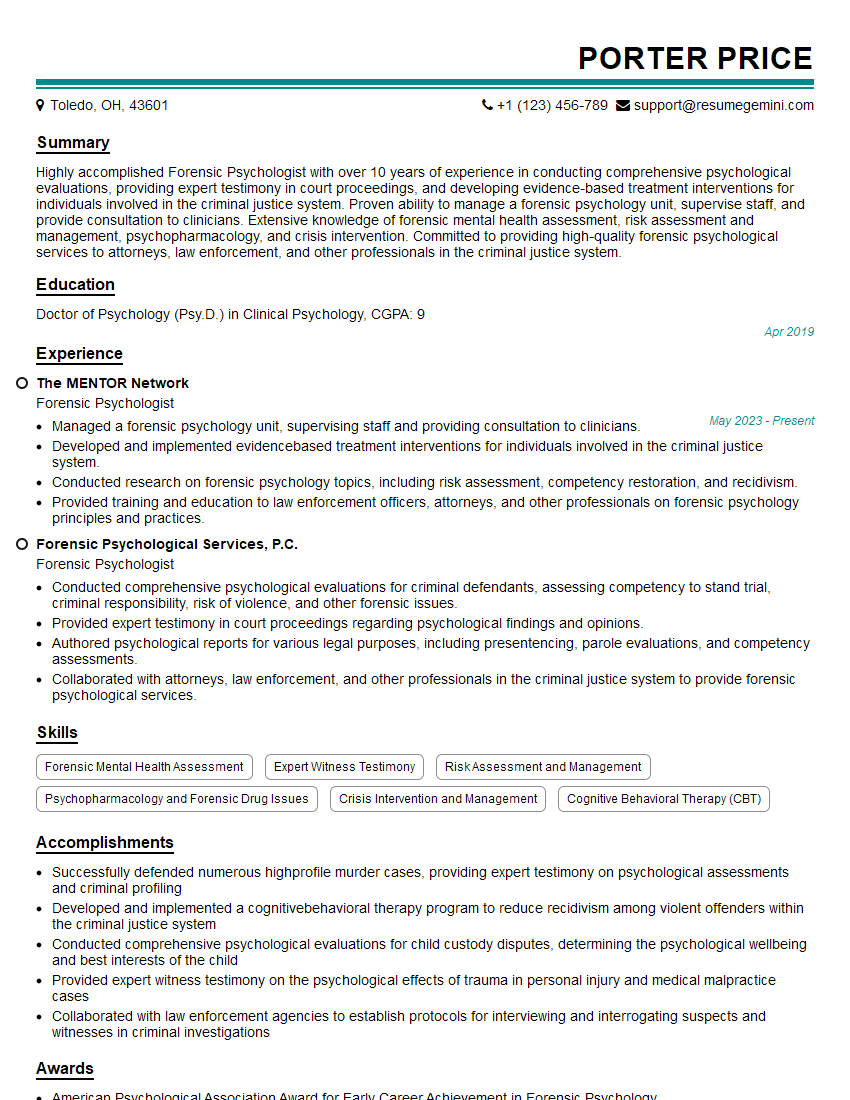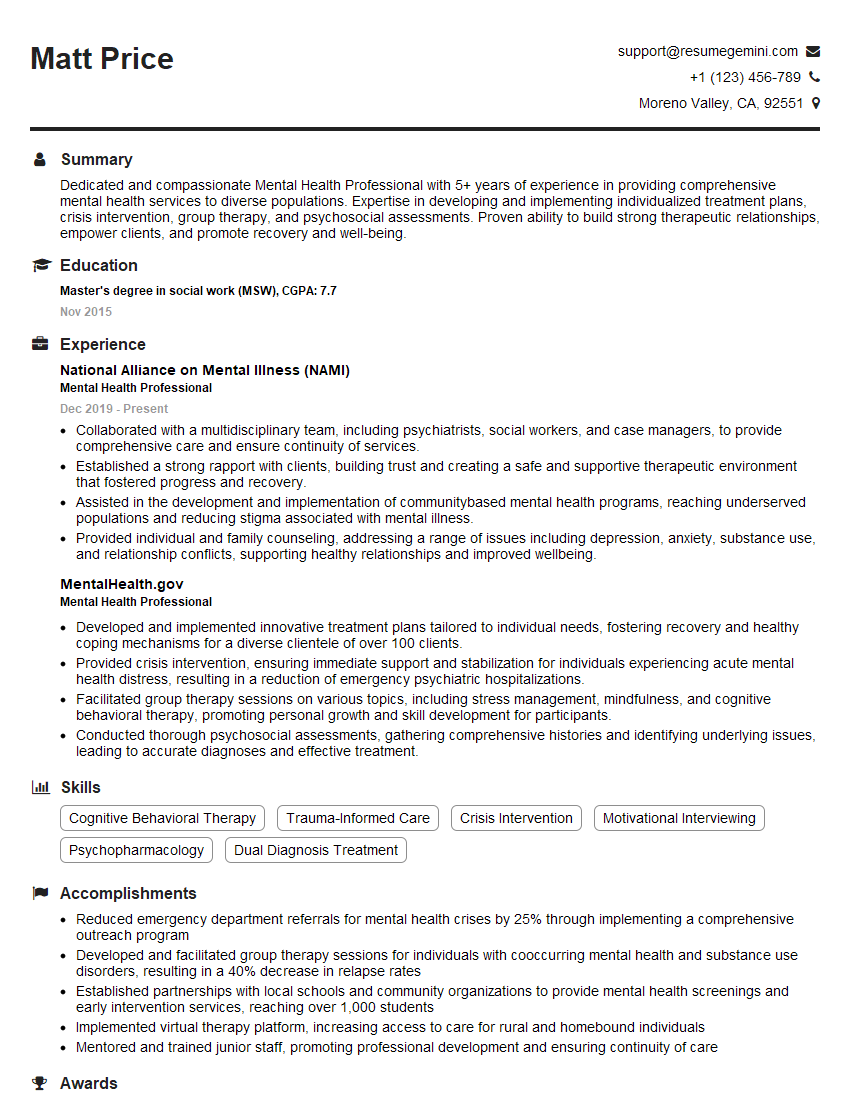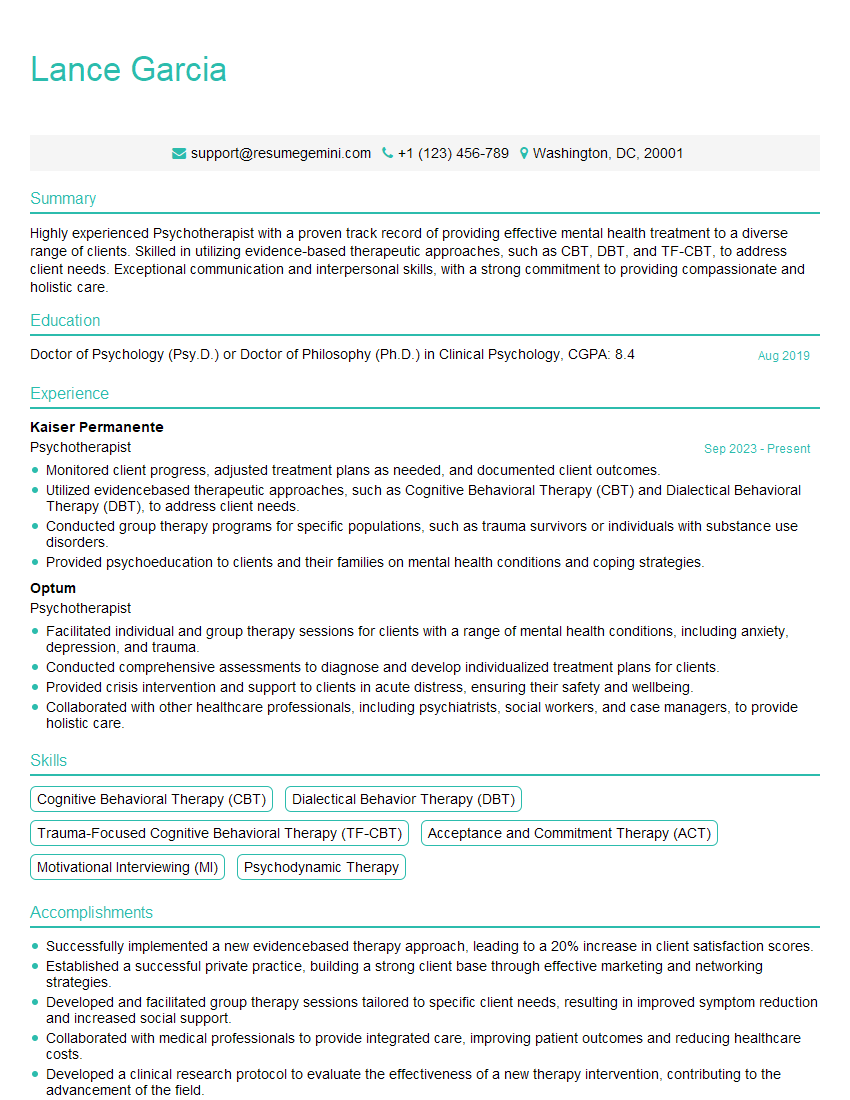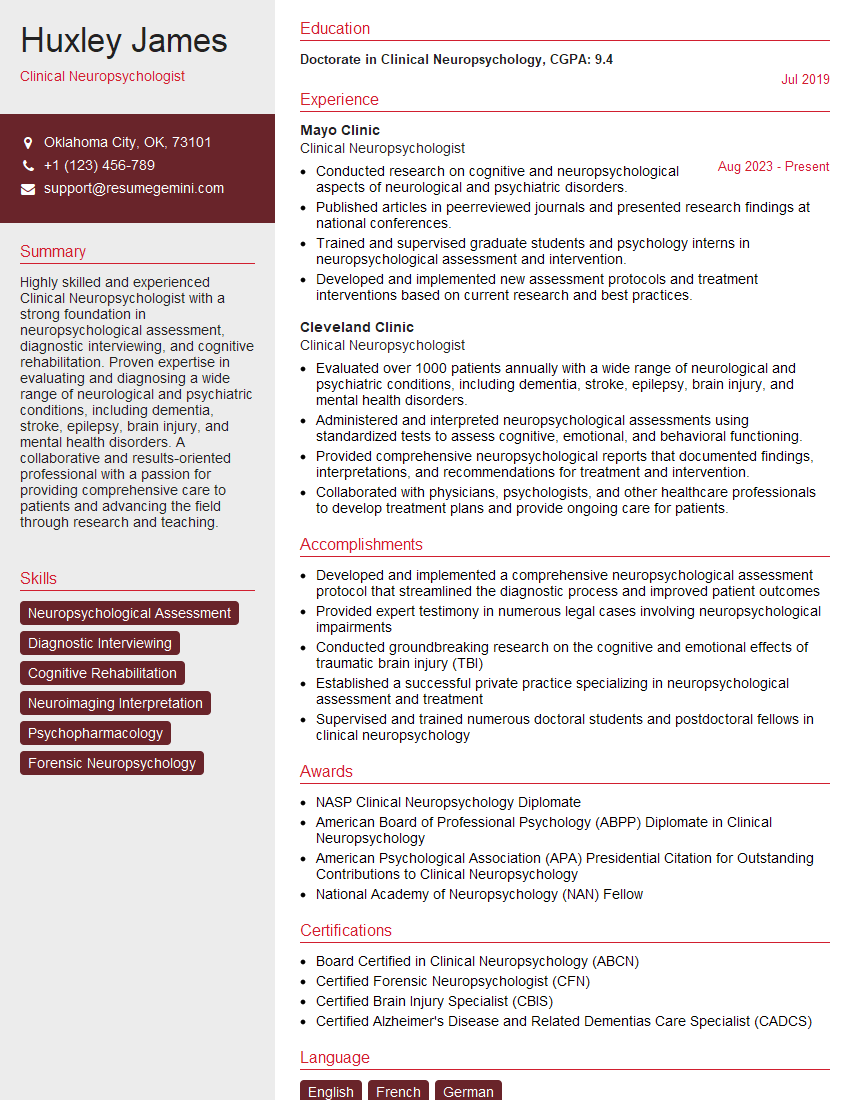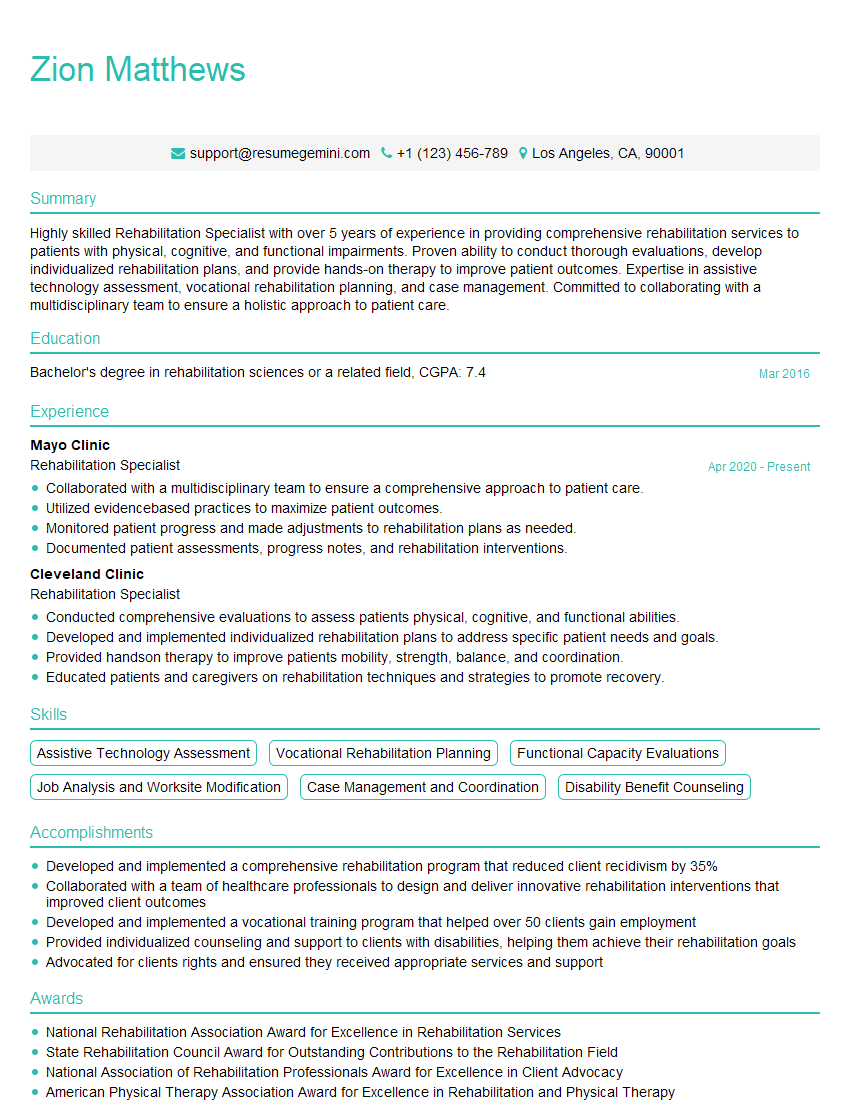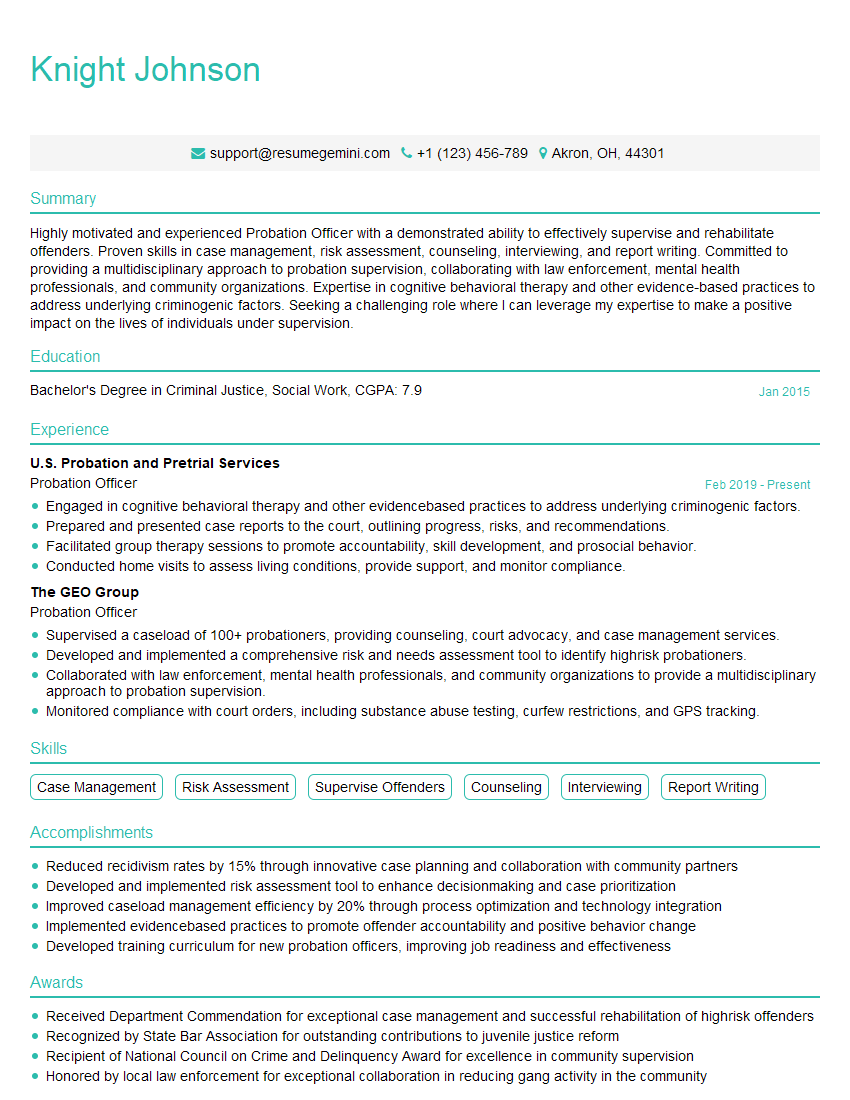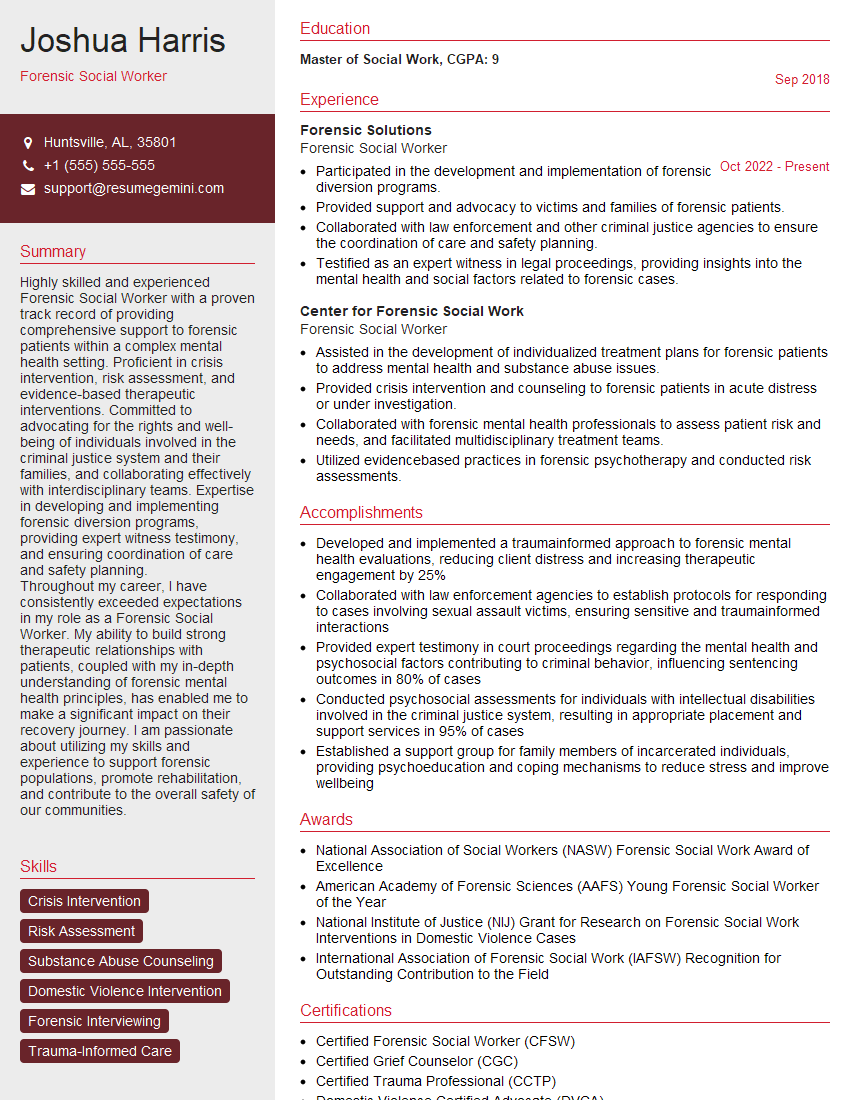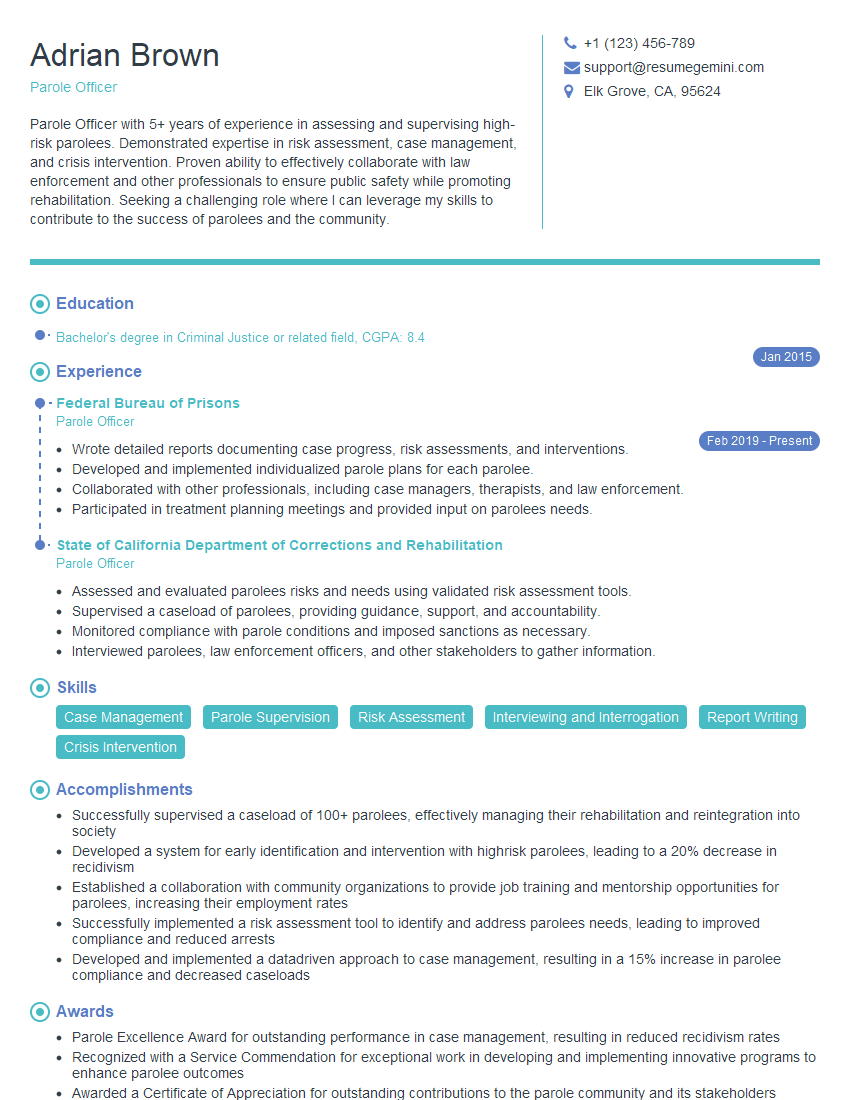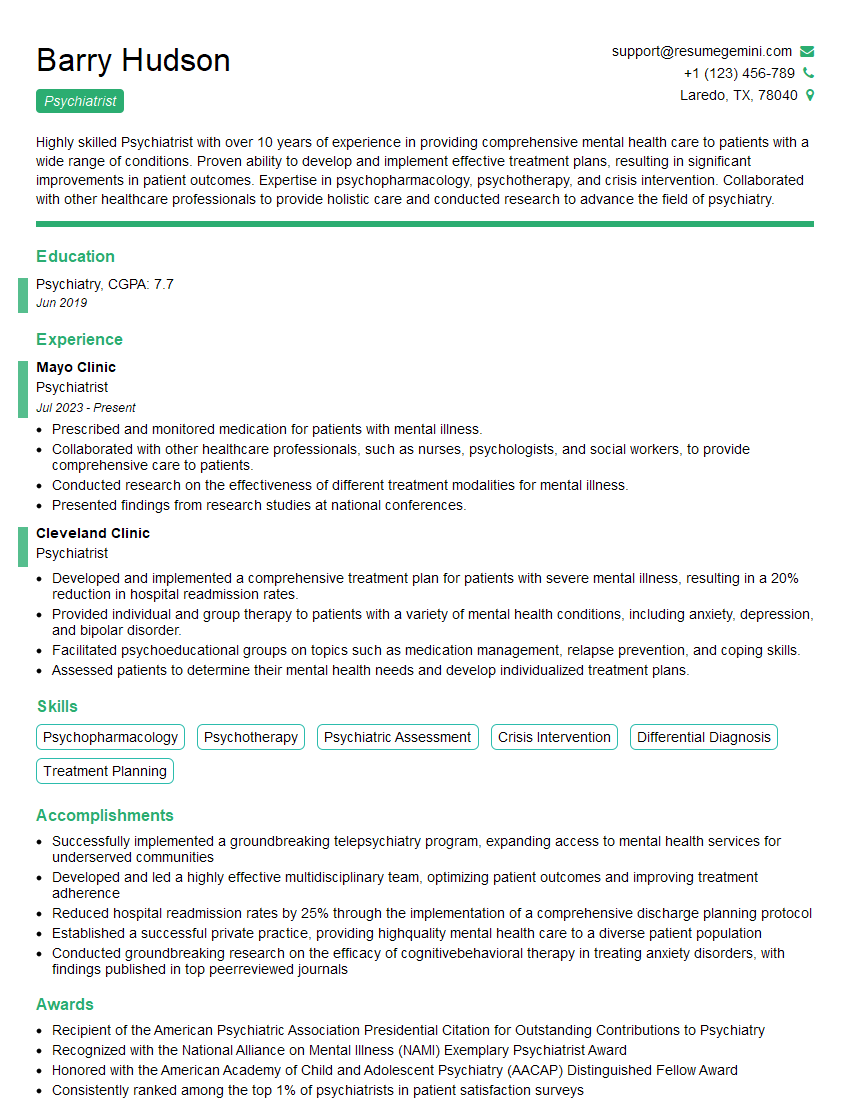Preparation is the key to success in any interview. In this post, we’ll explore crucial Psychopathy Assessment and Treatment interview questions and equip you with strategies to craft impactful answers. Whether you’re a beginner or a pro, these tips will elevate your preparation.
Questions Asked in Psychopathy Assessment and Treatment Interview
Q 1. Describe the PCL-R and its limitations in assessing psychopathy.
The Psychopathy Checklist-Revised (PCL-R) is the most widely used instrument for assessing psychopathy. It’s a 20-item rating scale completed by a clinician based on a semi-structured interview and review of collateral information (e.g., case files). Each item is rated on a 3-point scale (0, 1, 2), resulting in a total score. Higher scores indicate a higher level of psychopathy. The PCL-R assesses two key facets: Factor 1 (interpersonal and affective traits, such as glibness, superficial charm, grandiose sense of self-worth, and lack of remorse) and Factor 2 (lifestyle and antisocial behavior, such as impulsivity, irresponsibility, and criminal versatility).
However, the PCL-R has limitations. It’s primarily based on self-report and observable behaviors, which can be influenced by factors like the individual’s motivation to present themselves in a particular way. Its reliance on clinical judgment introduces subjectivity, leading to potential inconsistencies between raters. Moreover, it doesn’t capture the full spectrum of psychopathic traits, potentially overlooking individuals who exhibit some but not all of the characteristic features. The PCL-R also suffers from cultural bias, as the norms are primarily based on Western populations, leading to potentially inaccurate assessments in other cultural contexts. Finally, it doesn’t directly measure underlying neurological or biological factors contributing to psychopathy.
Q 2. Explain the difference between primary and secondary psychopathy.
The distinction between primary and secondary psychopathy is a crucial one. Primary psychopathy is characterized by a more profound lack of empathy, remorse, and guilt, often coupled with a higher level of interpersonal manipulation and superficial charm. These individuals often exhibit a callous disregard for others’ feelings and a pattern of antisocial behavior driven by a lack of concern for consequences. Think of it as a more inherent, ingrained personality structure. Secondary psychopathy, on the other hand, often involves more impulsive, reactive aggression and antisocial behavior, which is driven by factors like anxiety, fear, and a need for excitement. These individuals may demonstrate some empathy and remorse, although they might be overshadowed by their impulsive behaviors. They are frequently more emotionally reactive and prone to anxiety than individuals with primary psychopathy. The distinction is not always clear-cut, and many individuals may show characteristics of both types.
Imagine two individuals committing a robbery: A primary psychopath meticulously plans the robbery, showing no remorse afterward, perhaps even enjoying the thrill. A secondary psychopath, might commit the robbery impulsively due to financial desperation, later feeling remorseful about the act. The motivations and emotional responses differ significantly.
Q 3. Discuss the role of neuroimaging in the assessment of psychopathy.
Neuroimaging techniques like fMRI and PET scans play a growing role in understanding the neurobiological underpinnings of psychopathy. Studies have revealed structural and functional differences in the brains of individuals with psychopathic traits compared to controls. For example, reduced activity in brain regions associated with emotional processing (amygdala) and empathy (anterior cingulate cortex) has been consistently reported. Similarly, differences in the prefrontal cortex, responsible for executive functions like planning and impulse control, have been observed. This doesn’t mean a brain scan can definitively diagnose psychopathy, but it can provide valuable insights into the neurobiological correlates of the disorder, contributing to a more comprehensive assessment.
However, it’s crucial to acknowledge that neuroimaging findings are not yet used diagnostically in a clinical setting. The results are complex and still need further investigation to establish reliable markers for psychopathy. Further research is crucial to enhance our understanding of how these neural differences relate to behavioral manifestations and inform more effective treatment approaches.
Q 4. What are the ethical considerations in assessing and treating individuals with psychopathic traits?
Assessing and treating individuals with psychopathic traits present significant ethical challenges. The potential for manipulation and deception by individuals with these traits requires clinicians to be highly vigilant and adopt rigorous assessment methods. Confidentiality must be carefully balanced with the safety of the individual and the community, especially when there’s a risk of harm to others. Moreover, the limited effectiveness of many treatment modalities raises ethical questions about resource allocation and the potential for false hope. The risk of misdiagnosis and the potential for stigmatization further highlight the importance of ethical considerations.
For instance, mandatory treatment may raise concerns about autonomy and coercion. Clinicians must ensure informed consent and carefully consider the potential for misuse of assessment information. Transparency and a thorough explanation of the assessment process and its limitations are crucial in upholding ethical principles.
Q 5. Outline the key elements of a comprehensive psychopathy assessment.
A comprehensive psychopathy assessment goes beyond simply administering the PCL-R. It requires a multi-method approach that integrates information from various sources. This includes a thorough clinical interview to explore the individual’s history, personality, and current functioning. Review of collateral information from family members, employers, or legal records is crucial to obtain a holistic picture of the individual’s behavior patterns. Psychological testing, beyond the PCL-R, might include measures of intelligence, personality, and emotional functioning. Behavioral observations during the assessment process provide further valuable insights. In some cases, neuropsychological testing might be considered to assess cognitive functioning and potential neurological underpinnings. The integration of all this data allows for a more nuanced and accurate assessment than any single measure could provide.
Imagine assessing a suspected corporate embezzler. The PCL-R would provide a score, but supplementing it with interviews, background checks, and observations of their demeanor during the assessment allows for a more comprehensive understanding of the extent of their psychopathic traits and the potential motivations behind their behavior.
Q 6. What are some common comorbid conditions associated with psychopathy?
Psychopathy frequently co-occurs with other mental health disorders. Substance use disorders are highly prevalent, with individuals exhibiting psychopathic traits often abusing alcohol or drugs to enhance impulsive behaviors or cope with underlying emotional dysregulation. Antisocial personality disorder is also commonly associated, although psychopathy is considered a more severe and distinct condition. Other comorbid conditions include other personality disorders such as narcissistic personality disorder or histrionic personality disorder, attention-deficit/hyperactivity disorder (ADHD), and conduct disorder in youth. Understanding these comorbidities is essential for developing effective treatment plans, as addressing these co-occurring conditions can significantly improve overall outcomes.
For example, an individual with both psychopathy and substance use disorder requires targeted interventions for both conditions. Addressing only the substance abuse may leave the underlying psychopathic traits untreated, leading to relapse and continued antisocial behavior.
Q 7. Describe different treatment approaches for individuals with psychopathic traits.
Treatment for psychopathy is challenging due to the profound deficits in empathy, remorse, and prosocial behavior. There’s no single “cure,” and the effectiveness of interventions is often limited. However, various approaches are used, focusing primarily on managing antisocial behavior and reducing recidivism. These approaches include cognitive-behavioral therapy (CBT) to target specific problematic behaviors, such as anger management and impulse control. Psychosocial interventions may focus on developing prosocial skills and enhancing empathy, though the success rate of these interventions is often debated. Pharmacological interventions are sometimes used to manage comorbid conditions, such as anxiety or substance abuse, but there are no medications specifically for psychopathy.
In recent years, there’s increasing interest in interventions that integrate neurobiological insights. However, it’s essential to be realistic about the limitations of treatment. The focus should be on risk management and reducing harm to others rather than expecting complete behavioral change in all cases. Treatment effectiveness is highly dependent on individual motivation and willingness to engage in therapy, which are often significant barriers in this population.
Q 8. How do you assess risk of violence in individuals with psychopathy?
Assessing the risk of violence in individuals with psychopathy is a complex undertaking, requiring a multifaceted approach that goes beyond simply relying on diagnostic criteria. It necessitates a thorough evaluation considering various factors that interact dynamically. We don’t predict violence; we assess risk. This involves integrating clinical interviews, psychological testing, and collateral information (e.g., criminal history, past behavior patterns reported by family or significant others).
- Historical risk factors: Past violent behavior is the strongest predictor. Frequency, severity, and context of previous violence are crucial.
- Clinical risk factors: This includes substance abuse, impulsivity, antisocial attitudes, and a lack of empathy. The presence of these factors significantly increases the likelihood of future violent behavior. Psychometric assessments like the PCL-R (Psychopathy Checklist-Revised) can help identify these traits but should not be the sole basis for risk assessment.
- Situational risk factors: These are context-specific factors, such as access to weapons, stressful life events, and social supports (or lack thereof). A person might be less likely to engage in violence if surrounded by strong social networks or lacking access to weapons.
- Protective factors: These factors mitigate risk. Examples include strong social support, stable employment, engagement in prosocial activities, and access to appropriate treatment. A strong therapeutic alliance, for example, might help reduce risk factors, particularly impulsivity.
For example, a person with a history of assault, substance abuse, and antisocial attitudes but who is actively engaged in therapy, has stable housing, and strong family support would be considered at a lower risk of violence compared to someone with similar clinical traits who lacks social support, has limited access to resources, and actively avoids treatment.
Q 9. Explain the concept of ‘instrumental’ aggression in relation to psychopathy.
Instrumental aggression, a key characteristic associated with psychopathy, refers to violence that is planned and purposeful, used as a means to an end. It’s cold, calculated, and driven by personal gain rather than emotional reactivity or impulsive anger. Unlike reactive aggression (a response to perceived threat or provocation), instrumental aggression is premeditated and emotionally detached.
Imagine a scenario where an individual needs money and plans a robbery. This is instrumental aggression – the violence isn’t a spontaneous reaction but a calculated tool to achieve a specific objective. In contrast, reactive aggression might involve a bar fight stemming from an insult. The key difference lies in the premeditation and emotional detachment inherent in instrumental aggression.
Understanding this distinction is crucial for risk assessment and treatment planning. Individuals exhibiting predominantly instrumental aggression pose a unique challenge as they might be less amenable to traditional treatment approaches that rely on addressing underlying anger or emotional dysregulation.
Q 10. What are some effective strategies for managing manipulative behavior in individuals with psychopathy?
Managing manipulative behavior in individuals with psychopathy requires a highly structured and consistent approach. It’s not about changing their inherent personality traits, but rather establishing clear boundaries and preventing exploitation. Key strategies include:
- Clear and consistent boundaries: Establishing firm rules and consequences from the outset is crucial. Any violation should have immediate and consistent repercussions. This limits the individual’s ability to manipulate by exploiting inconsistent responses.
- Documentation and transparency: Maintaining detailed records of interactions and agreements helps mitigate manipulation attempts. Transparency in decision-making processes can deter attempts at subtle manipulation.
- Collaboration with a multidisciplinary team: This includes legal professionals, probation officers, and other relevant stakeholders to ensure a unified approach. The manipulation often goes beyond a single therapist’s domain.
- Focus on external validation: Instead of focusing on the individual’s internal justifications, concentrate on the objective consequences of their behavior. This avoids getting drawn into their manipulative narratives.
- Limit emotional engagement: Maintain a professional, objective stance to avoid becoming emotionally invested in the individual’s narrative, which they might exploit.
For example, setting clear limits on phone calls or visits, documenting all interactions, and informing relevant authorities about manipulative behaviors are all effective strategies. The goal isn’t to ‘win’ but to create an environment where manipulation is ineffective.
Q 11. How do you address the challenges of therapeutic alliance in treating psychopathy?
Building a therapeutic alliance with individuals with psychopathy presents significant challenges. Their superficial charm, lack of empathy, and manipulative tendencies can hinder the development of a genuine, trusting relationship. However, it’s not necessarily impossible. Success hinges on:
- Realistic expectations: Recognizing that a strong, emotionally intimate alliance might be unattainable. The focus shifts to a more functional, task-oriented relationship, focusing on concrete goals and behavioral change.
- Structured therapy: Using clearly defined boundaries, contracts, and agendas. This provides structure and predictability, which can be reassuring to individuals who might thrive on chaos and manipulation.
- Focus on instrumental benefits: Framing therapy as a means to achieve specific goals, such as avoiding legal consequences or improving social functioning. This appeals to their self-interest, a motivation often stronger than altruism.
- Confrontation without judgment: Addressing manipulative behaviors and dishonest responses directly, without becoming emotionally reactive or judgmental. A neutral, factual approach is crucial.
- Collaboration with other professionals: Utilizing a multidisciplinary approach to monitor progress, ensure accountability, and provide alternative perspectives.
It’s vital to remember that the goal is not to become their friend but to facilitate positive behavioral changes. The alliance might be more task-focused than emotionally intimate.
Q 12. Discuss the role of family therapy in the treatment of individuals with psychopathic traits.
Family therapy can play a crucial, albeit challenging, role in the treatment of individuals with psychopathic traits. The focus is not on directly treating the individual with psychopathy (as they are often resistant to traditional therapeutic approaches), but rather on supporting the family system’s ability to cope with the individual’s behavior.
The therapy aims to:
- Educate the family: Providing education on psychopathy, its symptoms, and effective coping strategies.
- Improve family communication: Developing healthy communication patterns to reduce conflict and manipulation.
- Enhance family boundaries: Establishing firm limits and consequences for the individual’s behavior.
- Support the family’s emotional well-being: Addressing the emotional impact of the individual’s actions on family members through individual or group therapy.
- Develop crisis management plans: Creating strategies to handle the individual’s potentially problematic behaviors.
Family therapy should be considered when the family is willing to participate and acknowledges the importance of setting consistent boundaries. The family’s needs must be addressed, even if the individual with psychopathy shows little to no interest in changing their behavior. For instance, teaching family members to recognize manipulative tactics and not engage with them directly can be invaluable. The overall goal is to create a healthier, safer family environment despite the individual’s challenges.
Q 13. What are the limitations of cognitive-behavioral therapy (CBT) in the treatment of psychopathy?
While Cognitive Behavioral Therapy (CBT) is a widely effective treatment modality for many mental health conditions, its application to psychopathy faces significant limitations. This stems primarily from the core traits of psychopathy: a lack of empathy, superficial charm, and manipulative tendencies.
Limitations include:
- Lack of motivation for change: Individuals with psychopathy often lack the intrinsic motivation needed to engage fully in the self-reflection and behavioral modification central to CBT. Their manipulative behavior may also thwart therapeutic progress.
- Difficulty with emotional regulation: CBT relies on the ability to identify and regulate emotions. The emotional detachment characteristic of psychopathy hinders this process. The emotional detachment observed in psychopathy renders the affective components of CBT less effective.
- Resistance to treatment: Manipulative tactics and superficial charm can be employed to undermine the therapeutic process and gain advantages, thwarting the goals of therapy.
- Limited insight: Individuals with psychopathy often lack the self-awareness needed to recognize the impact of their behavior on others. This hinders their ability to benefit from the self-reflective components of CBT.
Therefore, while CBT can be used as a *component* of a broader treatment approach, it’s unlikely to be effective as a standalone treatment for psychopathy. Other interventions, such as targeting specific behavioral problems or focusing on reducing risk factors, are likely more beneficial.
Q 14. Describe different risk assessment tools used for individuals with psychopathy.
Several risk assessment tools are used for individuals with psychopathy, but it’s crucial to remember that no single tool is definitive. They should be used in conjunction with clinical judgment and a comprehensive evaluation.
- Psychopathy Checklist-Revised (PCL-R): This is the most widely used instrument for assessing psychopathy. It’s a structured interview and rating scale that evaluates 20 personality traits and behavioral patterns. The PCL-R provides a score that helps gauge the severity of psychopathic traits, which is then linked to risk assessment through statistical research and clinical experience.
- Hare Psychopathy Checklist-Youth Version (PCL:YV): This is an adaptation of the PCL-R for adolescents. It assesses similar traits, adapted for a developmental stage.
- Violence Risk Appraisal Guide (VRAG): This actuarial instrument uses a combination of historical, clinical, and situational factors to predict recidivism, including violent re-offense. While not specific to psychopathy, it’s frequently employed.
- Historical-Clinical-Risk Management-20 (HCR-20): This structured professional judgment scale assesses risk in three domains: historical (past behavior), clinical (current symptoms), and risk management (future opportunities for intervention). It’s highly flexible and used across diverse clinical populations, including those with psychopathy.
Each tool has strengths and limitations. The PCL-R focuses primarily on personality traits, while the VRAG and HCR-20 consider a broader range of factors. It’s essential to use these instruments as part of a holistic assessment, integrating the results with other information gathered from interviews, collateral reports, and behavioral observations.
Q 15. How do you maintain confidentiality while working with individuals with psychopathy?
Maintaining confidentiality is paramount in all therapeutic relationships, but it’s especially crucial when working with individuals with psychopathy. These individuals may be highly manipulative, and breaches of confidentiality could have severe consequences, including putting the therapist or others at risk. My approach involves:
- Strict adherence to ethical guidelines: This includes following HIPAA regulations (in the US) or equivalent legal frameworks in other jurisdictions. I meticulously document all sessions and maintain secure storage of client records.
- Informed consent: I clearly explain the limits of confidentiality from the outset, including situations where I am legally obligated to disclose information (e.g., threat of harm to self or others). This conversation is conducted in a way that’s understandable and avoids overly technical jargon.
- Supervision and consultation: I regularly discuss challenging cases with supervisors or colleagues to gain perspective and ensure ethical decision-making. This provides an essential safety net and promotes best practice.
- Self-reflection and awareness: Recognizing my own boundaries and potential vulnerabilities is critical. Understanding the manipulative tactics employed by individuals with psychopathy can help prevent exploitation and maintain appropriate professional distance.
For example, if a client were to confess to a past crime that didn’t involve immediate harm, I would not report it unless legally mandated. However, if they threatened to harm someone, I am ethically bound to inform the relevant authorities and the intended victim.
Career Expert Tips:
- Ace those interviews! Prepare effectively by reviewing the Top 50 Most Common Interview Questions on ResumeGemini.
- Navigate your job search with confidence! Explore a wide range of Career Tips on ResumeGemini. Learn about common challenges and recommendations to overcome them.
- Craft the perfect resume! Master the Art of Resume Writing with ResumeGemini’s guide. Showcase your unique qualifications and achievements effectively.
- Don’t miss out on holiday savings! Build your dream resume with ResumeGemini’s ATS optimized templates.
Q 16. How do you handle countertransference in the therapeutic relationship with individuals with psychopathy?
Countertransference, the therapist’s emotional reaction to the client, is particularly significant in working with individuals with psychopathy. Their charm, manipulation, and lack of remorse can evoke strong feelings in therapists, ranging from admiration to anger or disgust. Managing this is critical for effective treatment and the therapist’s well-being. I address countertransference by:
- Self-awareness: Regularly reflecting on my emotional responses to the client, identifying potential triggers, and understanding the roots of those feelings.
- Supervision and consultation: Discussing my reactions with a supervisor provides an objective perspective and helps process complex emotional responses.
- Maintaining professional boundaries: Setting clear limits on the therapeutic relationship, avoiding overly familiar interactions, and adhering to a strict professional demeanor.
- Utilizing therapeutic techniques: Employing techniques to manage my own emotions, such as mindfulness or grounding exercises, is crucial. This ensures I remain objective and effective in the therapeutic process.
For instance, a client might try to charm me into bending the rules or sharing personal information. Recognizing this as a manipulative tactic allows me to maintain appropriate boundaries and address it directly in therapy, focusing the conversation back on the client’s behavior and its impact.
Q 17. What are the legal and ethical implications of involuntary treatment for psychopathy?
Involuntary treatment for psychopathy raises significant legal and ethical concerns. The fundamental principles of autonomy and informed consent are challenged when treatment is imposed without the individual’s consent. Legally, involuntary commitment typically requires evidence of imminent harm to self or others, a threshold that can be difficult to establish, particularly with psychopathy, where the risk is often long-term rather than immediate.
Ethically, forcing treatment raises questions about coercion and the individual’s right to refuse treatment. Even if legally permissible, involuntary treatment should prioritize the least restrictive option and be accompanied by regular review and consideration of the individual’s capacity for self-determination. The efficacy of such interventions is also debated, as the success of treatment often hinges on the client’s willingness to participate.
Consider the case of an individual with psychopathy who repeatedly violates parole but does not pose an immediate threat. While ethically questionable, there might be legal grounds for involuntary treatment based on risk assessment and the history of antisocial behavior, but this process must be carefully scrutinized and continually evaluated.
Q 18. Discuss the role of medication in the treatment of psychopathy.
Medication alone is not a primary treatment for psychopathy. Psychopathy is not a mental illness in the traditional sense, but rather a constellation of personality traits and behavioral patterns. While medication doesn’t directly address the core characteristics of psychopathy, it can manage co-occurring conditions like anxiety, depression, or aggression, thereby improving overall functioning and potentially reducing antisocial behavior. This is often a supportive role to therapy.
For example, an individual with psychopathy who also experiences severe anxiety might benefit from anti-anxiety medication. This would not ‘cure’ the psychopathy, but it could make them more receptive to therapy by reducing their anxiety levels, therefore improving their capacity to engage in therapy and address their behavioral issues. The use of medication should always be integrated into a comprehensive treatment plan that includes psychotherapy.
Q 19. What are some evidence-based practices for reducing recidivism in individuals with psychopathy?
Reducing recidivism in individuals with psychopathy requires a multi-faceted approach. Evidence-based practices include:
- Cognitive Behavioral Therapy (CBT): This targets the cognitive distortions and maladaptive behaviors that contribute to criminal behavior. It helps individuals develop healthier coping mechanisms and problem-solving skills.
- Dialectical Behavior Therapy (DBT): This teaches emotional regulation, distress tolerance, and interpersonal effectiveness skills, all vital for managing impulsive behavior and improving relationships.
- Anger Management Programs: These specifically address anger issues, a common feature in individuals with psychopathy.
- Substance Abuse Treatment: Addressing substance abuse is critical as it often exacerbates antisocial behavior.
- Long-term supervision and support: Ongoing monitoring and support are essential to prevent relapse after treatment. This could include parole supervision, regular check-ins with therapists, or participation in community support groups.
These interventions are most effective when tailored to the individual’s specific needs and implemented consistently. The emphasis on long-term, structured support reflects the chronic nature of the challenges posed by psychopathy and the need for ongoing engagement in treatment.
Q 20. Explain the concept of empathy deficits in psychopathy.
Empathy deficits are a core feature of psychopathy. Individuals with psychopathy struggle to understand and share the feelings of others. This isn’t simply a lack of compassion; it’s a fundamental difference in their emotional processing. They may appear to be empathetic, using charm and manipulation to mimic appropriate emotional responses, but they lack the genuine emotional connection.
Imagine a situation where someone is visibly distressed. A neurotypical individual would naturally feel concern and want to help. Someone with psychopathy might observe the distress but not experience a corresponding emotional response. They may even exploit the situation for personal gain, lacking the internal mechanism that generates empathy.
Assessment of empathy deficits involves using tools that evaluate emotional understanding, perspective-taking abilities, and the capacity for genuine emotional responses to others’ situations. The absence of these abilities is a significant indicator of psychopathy.
Q 21. How do you assess the presence of antisocial personality disorder in relation to psychopathy?
Antisocial Personality Disorder (ASPD) and psychopathy are related but distinct concepts. ASPD is a broader diagnostic category defined by a pattern of disregard for and violation of the rights of others. Psychopathy is a more specific construct within ASPD, characterized by a constellation of interpersonal, affective, and lifestyle traits, including superficial charm, manipulativeness, lack of remorse, and impulsivity. Not all individuals with ASPD are psychopathic.
Assessment involves using tools like the Psychopathy Checklist-Revised (PCL-R), which assesses specific psychopathic traits, in conjunction with diagnostic criteria for ASPD outlined in the DSM-5 (Diagnostic and Statistical Manual of Mental Disorders, 5th Edition) or ICD-11 (International Classification of Diseases, 11th Revision). The PCL-R goes beyond the diagnostic criteria of ASPD to evaluate the specific traits and personality characteristics associated with psychopathy. An individual may meet criteria for ASPD but not score highly on the PCL-R, indicating the absence of psychopathy despite antisocial behavior.
For example, someone might exhibit a pattern of criminal behavior (meeting ASPD criteria) due to poverty and lack of opportunity, lacking the core interpersonal and affective features associated with psychopathy.
Q 22. Describe the challenges in conducting research on psychopathy.
Researching psychopathy presents unique challenges due to the nature of the disorder itself. Individuals with psychopathic traits often manipulate or deceive, making accurate data collection difficult. Access to this population can be limited, as many individuals are incarcerated or unwilling to participate in studies. Ethical considerations are paramount, balancing the need for research with the rights and safety of participants. Furthermore, the heterogeneity of psychopathy – meaning individuals present with varying combinations of traits – makes it difficult to establish clear diagnostic criteria and track consistent outcomes across studies.
For instance, a longitudinal study tracking individuals with high PCL-R scores (Psychopathy Checklist-Revised) might find that some show consistent criminal behavior while others adapt and function successfully in society, highlighting the complexity of the disorder and the challenges of predicting long-term outcomes.
Finally, the lack of a universally accepted definition and diagnostic criteria across research projects adds another layer of complexity when trying to synthesize findings and draw robust conclusions.
Q 23. What are some limitations of using self-report measures in assessing psychopathy?
Self-report measures, while seemingly straightforward, suffer from significant limitations when assessing psychopathy. Individuals with psychopathic traits are often skilled at self-presentation and can deliberately misrepresent their behaviors and attitudes to create a favorable impression. They may lack insight into their own motivations and behaviors, leading to inaccurate self-reporting. For example, someone with psychopathic traits might underreport their history of impulsive aggression or manipulation, minimizing the severity of their actions.
Another key limitation is response bias. Individuals may answer questions in a way they believe will be socially desirable, even if it’s not entirely truthful. This makes it difficult to obtain a truly accurate picture of their personality and behavior. Therefore, self-report measures are generally considered insufficient on their own for a comprehensive psychopathy assessment; they are often used in conjunction with other assessment methods, such as clinical interviews and behavioral observations.
Q 24. How do you differentiate between psychopathy and other personality disorders?
Differentiating psychopathy from other personality disorders requires a careful and nuanced approach. While some overlap exists, key distinctions lie in the specific constellation of traits and the overall clinical presentation. Psychopathy, as assessed by instruments like the PCL-R, emphasizes interpersonal and affective traits such as superficial charm, grandiosity, manipulation, lack of remorse or guilt, and shallow affect. In contrast, other personality disorders, like antisocial personality disorder (ASPD), focus more on behavioral indicators such as impulsivity, aggression, and violation of social norms. ASPD may be a part of psychopathy’s presentation, but psychopathy encompasses more than just behavioral issues; it involves a deeper disturbance of personality and emotional functioning.
For example, someone with ASPD might engage in criminal behavior, but may also experience genuine remorse for their actions. An individual with psychopathy might commit similar acts but show a complete lack of empathy or remorse. Borderline Personality Disorder involves instability in mood, relationships, and self-image, unlike the often-stable and calculating nature observed in psychopathy. A skilled clinician considers the entire clinical picture, including the patient’s history, interpersonal relationships, and observed behavior, to make a differential diagnosis. It’s important to note that many individuals might exhibit traits of various personality disorders, and comorbidity (the co-occurrence of multiple disorders) is common.
Q 25. What are the implications of childhood trauma on the development of psychopathy?
The relationship between childhood trauma and the development of psychopathy is a complex area of ongoing research. While childhood trauma isn’t considered a direct cause, it’s widely recognized as a significant risk factor. Experiences such as neglect, abuse (physical, emotional, or sexual), and inconsistent parenting can disrupt normal brain development and emotional regulation. These experiences may lead to a lack of empathy, difficulty forming attachments, and increased impulsivity – all of which are characteristic of psychopathy.
However, it’s crucial to understand that not all individuals who experience childhood trauma develop psychopathy. Genetic predisposition, environmental factors, and resilience all play a role in shaping an individual’s personality and behavior. The impact of trauma is likely mediated through epigenetic changes, impacting gene expression and brain development. Some individuals may develop coping mechanisms that help them overcome the negative effects of trauma, while others may be more vulnerable.
Research suggests that trauma may be a significant contributor to the development of callous-unemotional traits, a core feature of psychopathy, particularly when combined with genetic vulnerabilities. Therefore, while not a deterministic factor, childhood trauma constitutes a significant environmental risk factor contributing to the development of psychopathic traits.
Q 26. Discuss the impact of neurobiological factors in the etiology of psychopathy.
Neurobiological factors play a substantial role in the etiology of psychopathy. Research suggests dysfunction in several brain regions, including the amygdala (processing fear and emotion), prefrontal cortex (executive functions like planning and decision-making), and the anterior cingulate cortex (involved in empathy and error detection). These areas show structural and functional differences in individuals with psychopathy compared to neurotypical individuals.
Studies using neuroimaging techniques, such as fMRI and PET scans, have identified reduced activity and volume in the amygdala, potentially explaining the lack of fear conditioning and emotional responsiveness often seen in psychopathy. Similarly, impairments in the prefrontal cortex might contribute to impulsivity, poor planning, and deficits in behavioral inhibition. The interplay between genetic predisposition and environmental factors influences these neurobiological differences. Genetic studies have identified specific genes linked to various aspects of psychopathy, such as aggression, impulsivity, and callous-unemotional traits. These genetic factors may interact with environmental influences, such as trauma or neglect, to increase the risk of developing psychopathic traits.
It’s important to view this as a complex interplay rather than a simple cause-and-effect relationship. The neurobiological underpinnings of psychopathy are still being investigated, but current research points towards a combination of genetic vulnerabilities and environmental experiences shaping the neurobiological architecture of the brain, thereby contributing to the development of psychopathic traits.
Q 27. What is the role of a forensic psychologist in the legal system in regards to psychopathy?
Forensic psychologists play a crucial role in the legal system when it comes to psychopathy. Their expertise is frequently sought in several legal contexts. In criminal cases, forensic psychologists conduct evaluations to assess the defendant’s competency to stand trial, sanity at the time of the offense (for insanity pleas), and risk of future violence. These assessments often involve using psychopathy assessment tools like the PCL-R to understand the offender’s personality and risk profile, informing sentencing decisions and parole considerations.
In civil cases, forensic psychologists might be involved in assessing individuals for personal injury claims or custody disputes, where personality traits and capacity for insight might be relevant. Their expertise can help determine an individual’s suitability for specific programs or environments, like rehabilitation programs or community-based treatment. Their testimony in court provides expert opinions on the psychological aspects of a case, helping the judge or jury understand the psychological factors relevant to the legal proceedings.
The process involves a comprehensive evaluation using a variety of methods, including clinical interviews, psychological testing, review of records, and collateral information from family and others. The forensic psychologist’s role emphasizes objectivity and adherence to ethical guidelines to ensure the fairness and integrity of the legal process.
Q 28. How do you manage ethical dilemmas encountered when assessing or treating individuals with psychopathic traits?
Ethical dilemmas are frequently encountered when assessing and treating individuals with psychopathic traits. One major concern is the potential for manipulation and deception. Psychopathic individuals may attempt to mislead the clinician during assessment, impacting the accuracy of the evaluation. Maintaining professional boundaries and employing strategies to detect deception are critical. For example, a forensic psychologist might use multiple assessment methods to triangulate information or incorporate collateral information from multiple sources to verify a patient’s claims.
Another ethical challenge is the issue of confidentiality. If an individual poses a significant risk of harm to themselves or others, the clinician has a duty to breach confidentiality and inform the appropriate authorities. Balancing the individual’s right to confidentiality with the safety and well-being of others is a crucial ethical consideration. This often necessitates careful consideration and a thorough risk assessment before breaking confidentiality.
Treatment presents its own set of dilemmas. Many clinicians are hesitant to offer treatment due to the limited effectiveness of interventions and the potential for therapeutic manipulation. However, if an individual desires treatment, a clinician needs to weigh the ethical implications of providing potentially ineffective therapy versus the ethical obligation of not providing services. The focus should be on managing risk and preventing future harm, rather than attempting to fundamentally change the individual’s psychopathic traits. Careful consideration of the potential benefits and risks of treatment, coupled with clear therapeutic boundaries, is crucial.
Key Topics to Learn for Psychopathy Assessment and Treatment Interview
- Psychopathy Assessment Tools: Understanding the PCL-R, PCL:YV, and other relevant assessment instruments; their strengths, limitations, and appropriate application in diverse contexts.
- Differential Diagnosis: Distinguishing psychopathy from other personality disorders and mental illnesses presenting with similar symptoms. Practical application involves case studies and scenario-based analysis.
- Theoretical Frameworks: A solid grasp of prominent theories of psychopathy, including biological, psychological, and social perspectives. This includes understanding the interplay of these factors in individual cases.
- Treatment Approaches: Familiarity with evidence-based treatments for individuals with psychopathic traits, encompassing cognitive-behavioral therapy (CBT), dialectical behavior therapy (DBT), and other relevant interventions. Consider the challenges and limitations inherent in treating this population.
- Ethical Considerations: Navigating ethical dilemmas encountered in assessing and treating individuals with psychopathic traits, such as confidentiality, informed consent, and risk management. This involves understanding professional boundaries and legal implications.
- Risk Assessment and Management: Applying risk assessment tools and strategies to evaluate and manage the risk of violence or recidivism in individuals with psychopathic traits. This includes understanding actuarial and clinical judgment approaches.
- Forensic Applications: Understanding the role of psychopathy assessment in forensic settings, including criminal justice, correctional systems, and civil commitment proceedings.
- Research and Emerging Trends: Staying abreast of current research and emerging trends in the field, demonstrating a commitment to lifelong learning and professional development.
Next Steps
Mastering Psychopathy Assessment and Treatment opens doors to rewarding careers in forensic psychology, correctional settings, and clinical practice. To maximize your job prospects, creating a strong, ATS-friendly resume is crucial. ResumeGemini is a trusted resource that can help you build a professional resume tailored to highlight your skills and experience. We provide examples of resumes specifically designed for professionals in Psychopathy Assessment and Treatment to help you craft a compelling application that showcases your expertise and secures that interview.
Explore more articles
Users Rating of Our Blogs
Share Your Experience
We value your feedback! Please rate our content and share your thoughts (optional).
What Readers Say About Our Blog
This was kind of a unique content I found around the specialized skills. Very helpful questions and good detailed answers.
Very Helpful blog, thank you Interviewgemini team.
